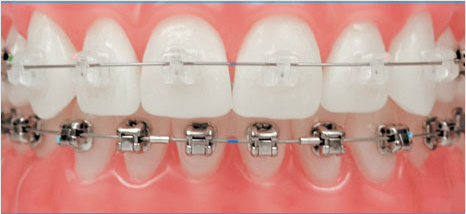Adult Orthodontics
Orthodontics and Adults
Orthodontic treatment can be successfully done at any age provided the patient has good bone health. Adults, especially appreciate the benefits of a beautiful smile. Sree dental hospital provides Traditional braces treatment, Colored braces treatment , Ceramic braces treatment, Self Ligating Bracket system, Lingual bracket system as well as Clear aligner (Invisalign/ Clear path) therapy for adults.
Dental health concerns are often the primary consideration for adult treatment. Crooked teeth and bad bites may affect oral health. Orthodontic treatment may help prevent many serious potential problems such as tooth decay, gum disease and eventual tooth loss.
Many adults are seeking braces to improve the appearance of their teeth and looks. The techniques used in the movement of adult teeth are similar to those used in children. Gaps between teeth, crowding, protruding front teeth, and teeth in abnormal positions are problems that may be corrected in the adult by orthodontic treatment.
As people become increasingly health conscious, orthodontists may see a continuing increase in the number of adult orthodontic patients. The use of small metal or clear (ceramic) braces has led to greater acceptance by adults to undergo orthodontic treatment. However, certain conditions cannot be resolved with braces alone, because an adult’s facial bones are no longer growing. Sometimes, jaw surgery is required to obtain the ideal result.
The health of teeth, gums and supporting bone, as well as harmonious jaw relationships, are key factors in determining the possibility of improving one’s appearance through orthodontic treatment.
With modern technologies and materials used in Orthodontics today, it is never too late to consider braces treatment for an adult. Braces are not only useful for cosmetic improvement but also it can treat your jaw joint function. If you are planning to get crowns, veneers or other restorative treatments for either cosmetic or functional reasons, braces may even be recommended to obtain the maximum result, because braces places teeth where they should be. Treatment time is not a big issue anymore as we are able to complete treatment in a minimal amount of time, often one year depending on the case type.
Types of Braces
Traditional Metal Braces
Traditional metal braces are the most common type of braces and are more comfortable. Brackets are bonded to the teeth, arch wires are placed through the brackets and small elastic bands secure the wire in the bracket. Tightening the arch wire gradually, move the teeth into proper position.
These braces are adjusted every 4-6 weeks to bring about the desired results. Although a little discomfort is expected during the treatment, today’s braces are more comfortable than ever before. These braces are made of high grade stainless steel which are smaller, lighter and show far less metal than the past.
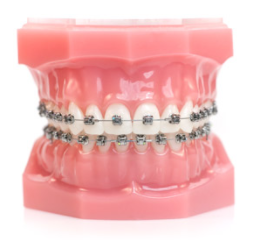
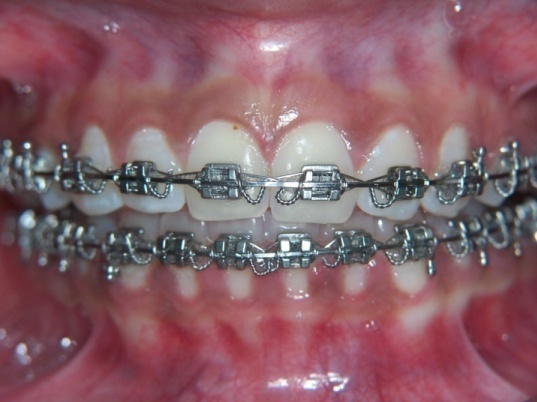
Colored Braces
Coloured braces are essentially a fixed brace with coloured elastic bands in place which can give a tailored aesthetic appeal to your new braces. They are available in many colours as seen below. They are typically changed at each visit.
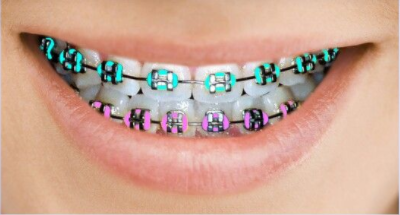
Ceramic Braces
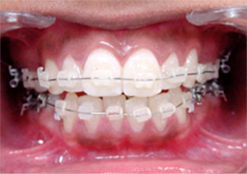
Ceramic braces are made of a clear ceramic material, and are therefore less visible on your teeth than metal braces. For this reason, these braces are used mainly on older teenagers and adult patients who have cosmetic concerns. While they are visually less prominent, they do require more attention to oral hygiene as ceramic braces are larger and are more brittle than their metal counterparts. These brackets are expensive compared to the regular metal brackets as they are more esthetic i.e.; they are less conspicuous.
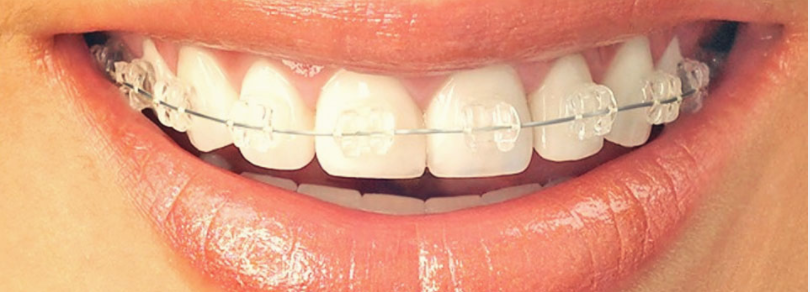
Self Ligating System
One of the most significant differences from conventional dental braces is the absence of elastic ligature (bands or ties). Self-ligating braces typically are smaller and more aesthetic since a metal door is required to hold wires in place. The self-ligating braces uses a slide mechanism to hold the archwire, thus reducing the amount of pressure exerted on the teeth.
Both traditional and self ligation (DAMON) braces achieve the same results, but the self ligation style is typically easier to tolerate.
The differences include:
Looks
With self ligation braces, elastic bands are eliminated and the braces are less obvious in their appearance.
How they work
While both styles of orthodontic treatment get the same results, the way those results are achieved is different. Traditional braces uses a system in which you return to the orthodontist every four to six weeks to have them tightened for the teeth to move. Self ligation braces work by using tiny spring loaded door to maintain pressure on the archwires. This process applies pressure to the system to gently adjust the teeth to the desired position. Because of the new technology used in self ligation braces, the need for tightening is eliminated frequently.
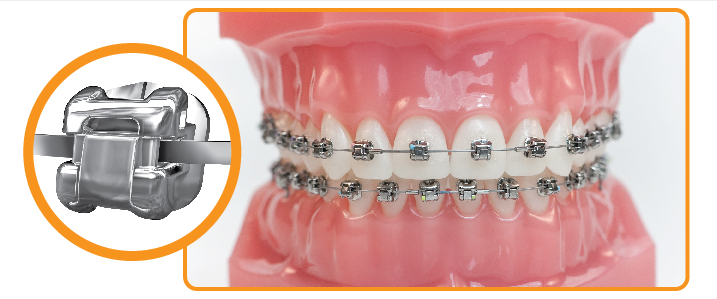
Tooth Extractions
Many people who get traditional braces treatment must have several teeth removed in the process. This is to make enough room for crowded teeth. With self ligation braces teeth removal is not typically necessary. While in some cases extractions are needed, it is much less often than with traditional braces. In addition, the need for expanders and headgear is significantly reduced. This is due to the self ligation method using the body’s natural ability to adapt during the process.
Time Involved
Because self ligation braces don’t require tightening, the appointments throughout treatment are spaced further apart than with conventional treatment. In many cases actual time during the appointment is also shorter.
Length of the treatment
Self ligating braces treatment typically lasts six months shorter than treatment with conventional braces. In addition, approximately fewer check-up appointments are required with this system.
The self ligation braces also help in maintaining the hygiene in an easier way as cleaning around the braces is much easy compared to traditional braces. With several advantages this latest system may be more expensive in treatment but helps the patient in reduction of treatment time and also requirement of tooth removal is minimised.
